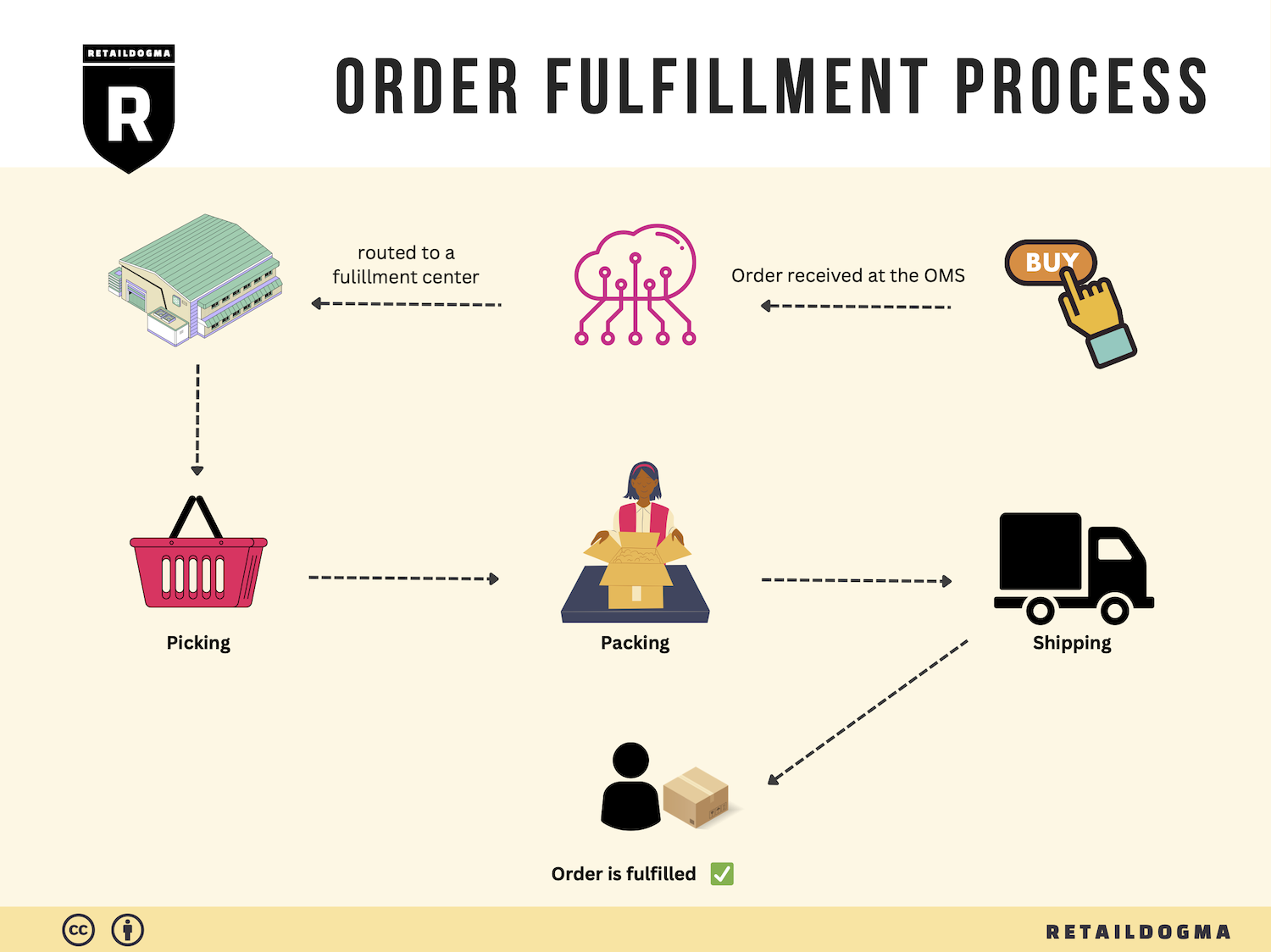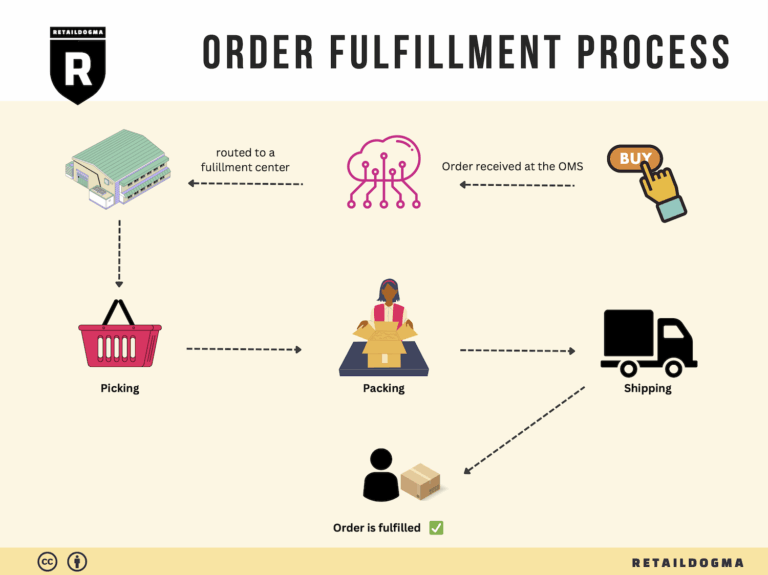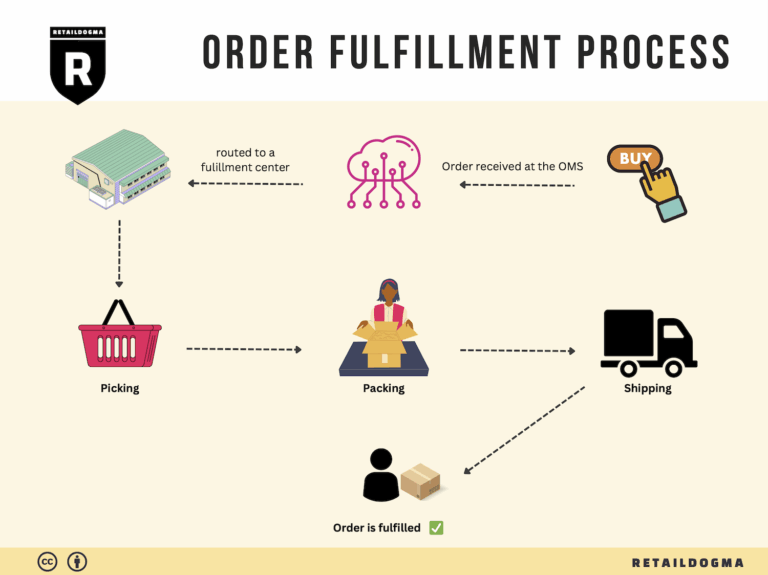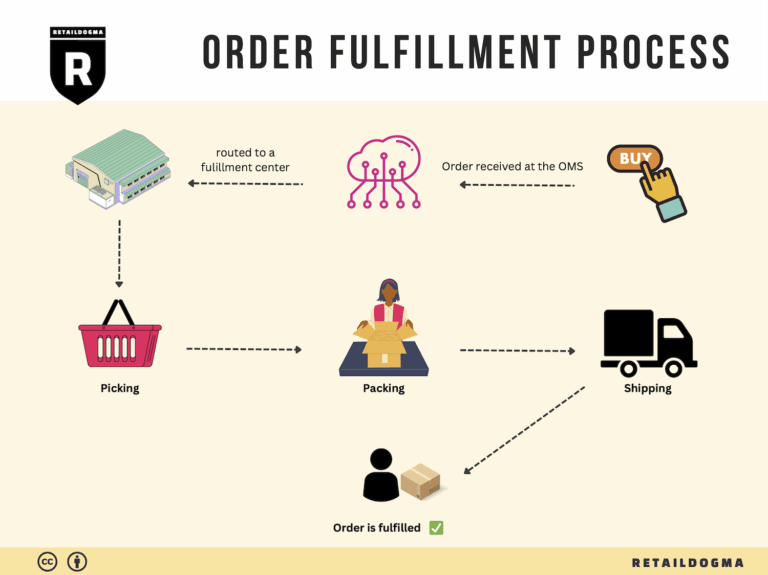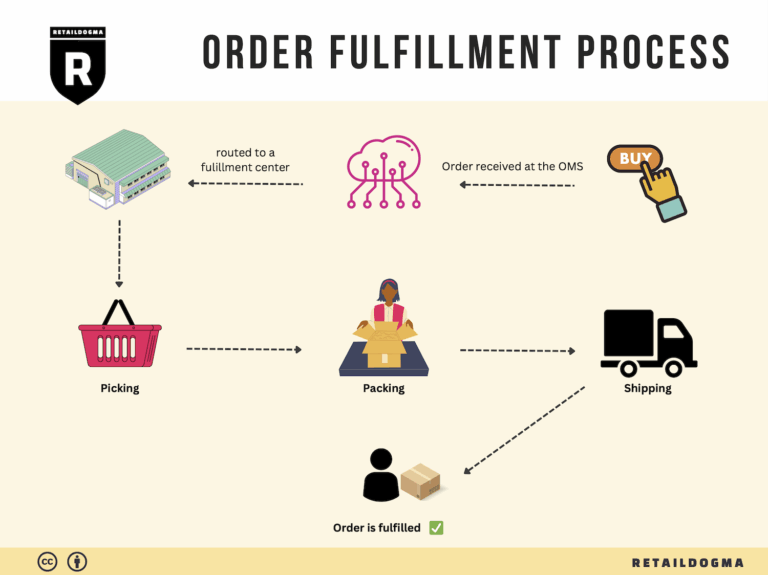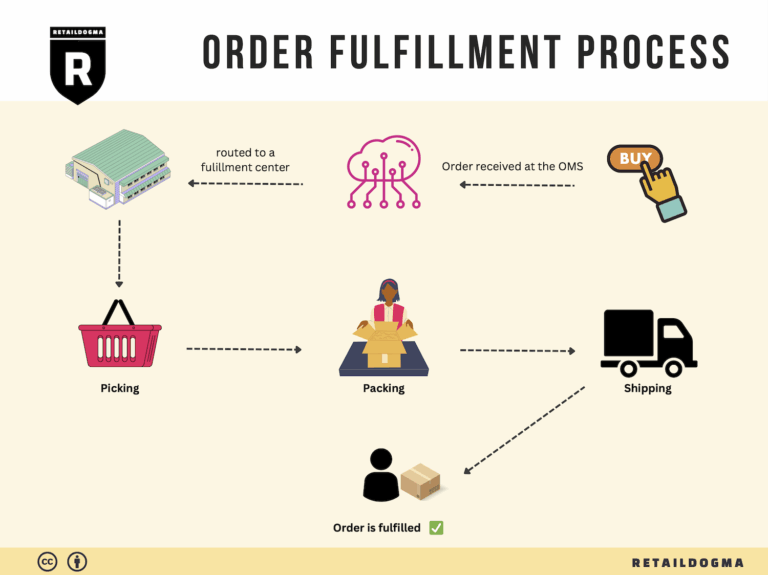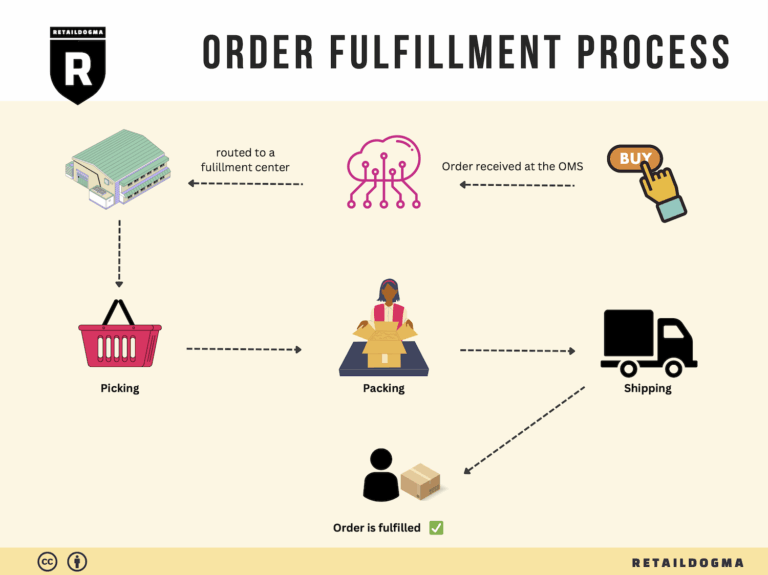Ecommerce Fulfillment Services: The Ultimate Guide (2025)
What is E-commerce Fulfillment? An Introduction for Growing Businesses
Understanding E-commerce Fulfillment
For many growing e-commerce businesses, the excitement of increasing sales can quickly become overshadowed by the daunting task of managing packing and shipping orders. As your sales volume rises, so too does the complexity of your logistics operations. The challenge of efficiently getting products to customers can lead to frustration, delays, and even damage to your brand’s reputation. This is where effective e-commerce fulfillment comes into play.
At its core, e-commerce fulfillment is the process of getting a product from your inventory to your customer’s doorstep. It encompasses everything from receiving and storing inventory, to picking, packing, shipping, and handling returns. As the backbone of your online business, fulfillment can significantly impact customer satisfaction and your overall operational efficiency.
In this guide, we will explore various fulfillment models available to businesses today, including Third-Party Logistics (3PL) providers and Amazon’s Fulfillment by Amazon (FBA) service. Each model has its unique advantages and can be tailored to fit different business needs and growth trajectories.
We will also dive into the core services offered by fulfillment partners, such as inventory management, order processing, and shipping logistics. Understanding these services is crucial for selecting a partner that aligns with your business goals and can scale with you as you grow.
Choosing the right fulfillment partner is a pivotal decision that can affect your bottom line and customer experience. We will provide practical advice on what to look for in a fulfillment partner, including service capabilities, technology integration, and customer support.
Finally, we will discuss pricing structures associated with fulfillment services, including how to evaluate costs effectively and identify hidden fees that could impact your profitability.
The goal of this guide is to empower you, as an e-commerce business owner or operations manager, to make informed decisions about your logistics strategy. By understanding the intricacies of e-commerce fulfillment and the options available, you can streamline your operations, enhance customer satisfaction, and ultimately drive growth in your business.

What You’ll Learn In This Guide
- What is E-commerce Fulfillment? An Introduction for Growing Businesses
- The Order Fulfillment Process: From ‘Buy’ Button to Customer’s Door
- Comparing Fulfillment Models: In-House vs. 3PL vs. Dropshipping
- A Deep Dive into Amazon FBA: Pros, Cons, and Who It’s For
- Core Services Offered by Fulfillment Centers
- How to Choose a Fulfillment Partner: A 6-Point Checklist
- Understanding Fulfillment Pricing: A Breakdown of Common Fees
- Frequently Asked Questions (FAQs) about Fulfillment
- Conclusion: Is Outsourcing Fulfillment the Right Move for Your Business?
- Important Disclaimer
The Order Fulfillment Process: From ‘Buy’ Button to Customer’s Door
1. Receiving Inventory
The first step in the order fulfillment process is receiving inventory at the fulfillment center, such as the HSV1 facility located in Madison, Alabama. This stage involves checking incoming shipments against purchase orders to ensure that the correct quantities and products have arrived. Key tasks include inspecting the items for any damage and organizing them for storage.
Importance: This step is crucial as it establishes the foundation for accurate inventory levels. Errors at this stage can lead to stock discrepancies, affecting order fulfillment downstream.
Key Term: SKU (Stock Keeping Unit) – A unique identifier for each product, used to track inventory levels and manage stock efficiently.
2. Warehouse Storage
Once inventory is received, it is placed into designated storage areas within the warehouse. This can involve shelving, pallets, or bins, depending on the product type. Effective organization is essential, and many facilities use a systematic approach, such as FIFO (First In, First Out), to ensure older stock is sold before newer stock.
Importance: Proper warehouse storage maximizes space utilization and ensures quick access to products. A well-organized warehouse minimizes the time spent locating items, which is vital for maintaining a fast-paced fulfillment operation.
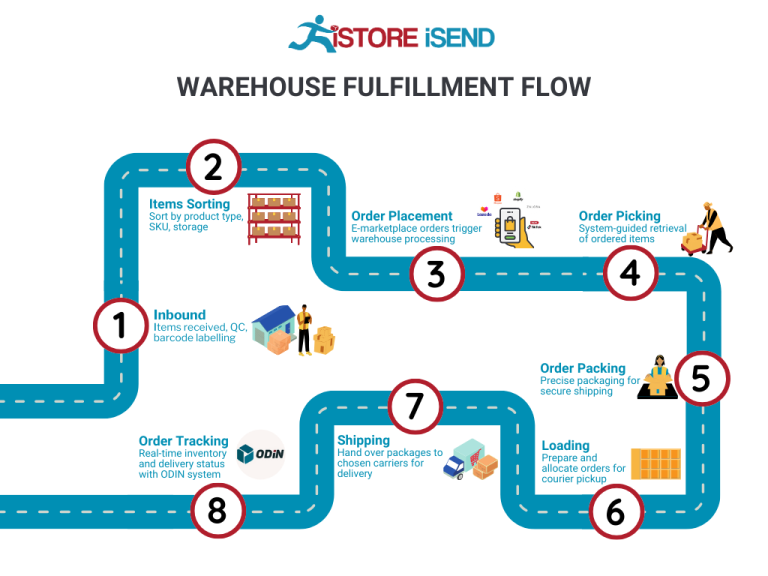
Key Term: Location Code – A specific code assigned to each storage area, allowing for efficient inventory management and retrieval.
3. Order Picking
When a customer places an order, the next step is order picking. This process involves retrieving the items from their storage locations based on the order details. Fulfillment centers often employ technology like barcode scanners and pick-to-light systems to streamline this process and reduce errors.
Importance: Efficient order picking is critical for meeting customer expectations, especially in e-commerce where speed is often a competitive advantage. Delays or inaccuracies in picking can lead to customer dissatisfaction and increased return rates.
Key Term: Pick Lists – Documents or digital displays that outline the items to be collected for each order, often sorted by storage location to optimize the picking route.
4. Order Packing
After items are picked, they move to the packing station. Here, items are carefully packed into boxes or envelopes, ensuring they are secure and protected during transit. This step may also involve adding packing slips, promotional materials, or branded packaging.
Importance: Proper packing is essential to prevent damage during shipping and to create a positive unboxing experience for the customer. It also plays a role in branding, as well-packaged items reflect professionalism and attention to detail.
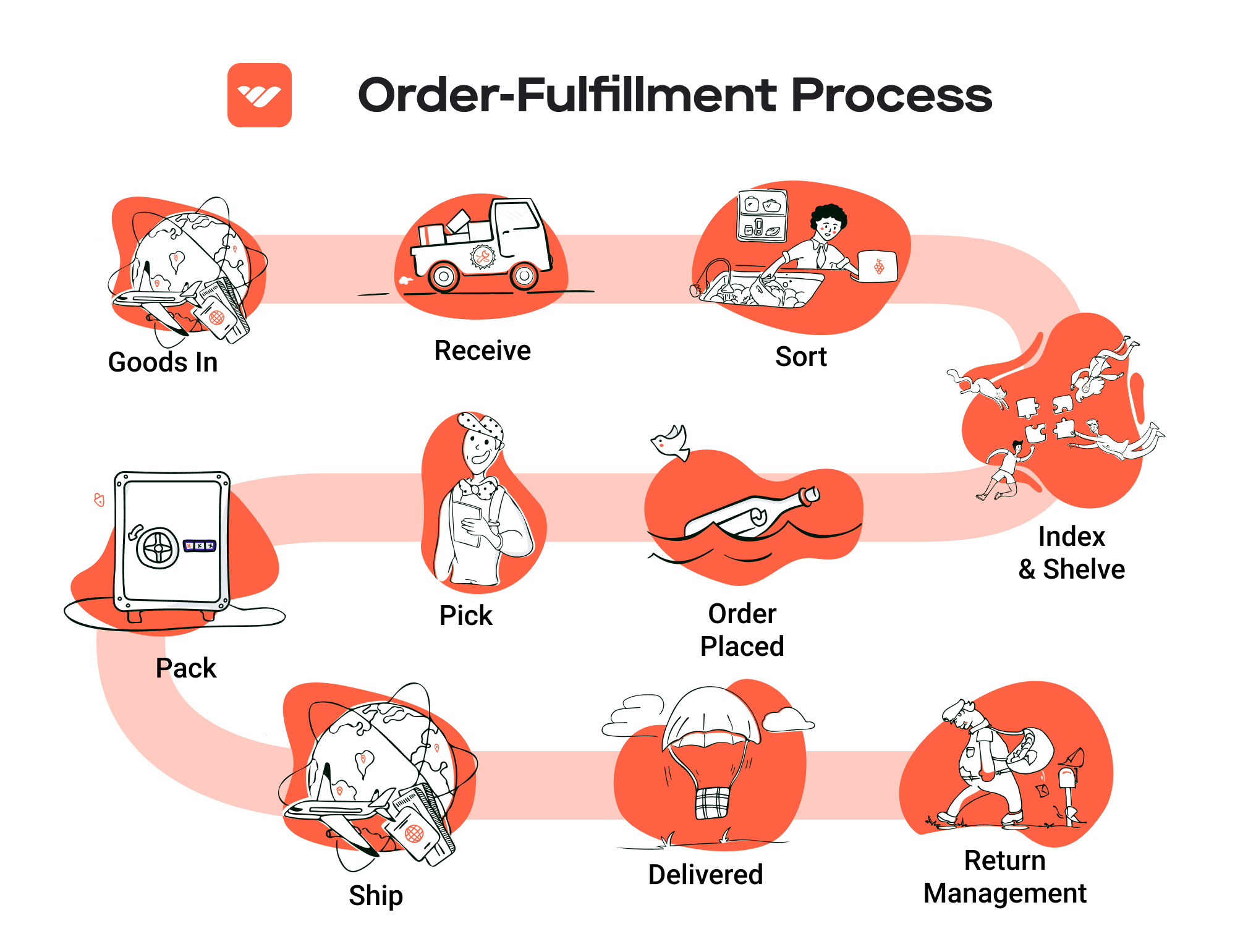
Key Term: Packing Slip – A document included in the package that lists the items included in the shipment, serving as a receipt for the customer.
5. Shipping & Delivery
The final step in the order fulfillment process is shipping the packed orders to customers. This involves selecting the best shipping carrier based on cost, speed, and reliability. Fulfillment centers like HSV1 often utilize multiple carriers, such as UPS, FedEx, or USPS, to optimize delivery options.
Importance: Timely shipping is critical for customer satisfaction. Delays at this stage can lead to negative reviews and decreased customer loyalty. Furthermore, tracking capabilities provided by carriers allow customers to monitor their shipments, enhancing transparency.
Key Term: Shipping Label – A label affixed to the package that contains the delivery address, tracking number, and shipping carrier information, facilitating the shipment process.
By understanding and optimizing each of these five steps—Receiving Inventory, Warehouse Storage, Order Picking, Order Packing, and Shipping & Delivery—e-commerce businesses can streamline their order fulfillment process. This not only enhances operational efficiency but also improves customer satisfaction and loyalty, ultimately driving growth in a competitive marketplace.
Comparing Fulfillment Models: In-House vs. 3PL vs. Dropshipping
Fulfillment Model Comparison
| Model | Who Handles Inventory | Best For (Business Stage) | Key Advantage | Key Disadvantage |
|---|---|---|---|---|
| In-House Fulfillment | The business itself | Startups and established brands | Full control over inventory and processes | Higher overhead costs and labor needs |
| Third-Party Logistics (3PL) | A third-party logistics provider | Growth phase businesses | Scalability and expertise in logistics | Less control over the fulfillment process |
| Dropshipping | Supplier or manufacturer | New and small businesses | Low overhead and no inventory risk | Lower profit margins and dependency on suppliers |
In-House Fulfillment
In-house fulfillment involves managing the entire logistics process within the business itself. This model is typically adopted by startups and established brands that want complete control over their inventory, shipping, and customer service. By handling fulfillment internally, businesses can customize their processes to meet specific customer needs, ensuring that they maintain quality and brand integrity throughout the order fulfillment process. This approach allows for better tracking and management of inventory, leading to enhanced customer satisfaction through faster shipping times and personalized packaging. However, the major drawback of in-house fulfillment is the significant overhead costs associated with warehousing, staffing, and technology. These costs can be a burden, especially for startups or smaller businesses that may not have the capital to sustain such operations. Additionally, the complexity of logistics may divert focus from core business activities, potentially hindering growth.
Third-Party Logistics (3PL)
Third-party logistics (3PL) refers to outsourcing the fulfillment and logistics processes to specialized service providers. This model is ideal for businesses in their growth phase that need to scale operations quickly without investing heavily in infrastructure. 3PL providers bring expertise in logistics, warehousing, and distribution, allowing businesses to leverage advanced technology and efficient processes that might otherwise be inaccessible. The key advantage of 3PL is scalability; as demand increases, businesses can easily adjust their logistics needs without the complexities of managing additional staff or warehouse space. However, one of the significant disadvantages is the loss of control over the fulfillment process. When relying on a 3PL provider, businesses must trust that the provider will maintain the same standards of quality and service that they would offer in-house. This can lead to potential issues with customer service and fulfillment accuracy, which can ultimately affect brand reputation.
Dropshipping
Dropshipping is a fulfillment model where the retailer does not hold inventory but instead transfers customer orders directly to the supplier or manufacturer, who then ships the products directly to the customer. This model is particularly suitable for new and small businesses that want to minimize overhead costs and financial risks associated with holding inventory. The primary advantage of dropshipping is that it eliminates the need for warehousing and inventory management, allowing entrepreneurs to focus on marketing and sales. Furthermore, it enables businesses to offer a wide range of products without the upfront costs of purchasing inventory. However, dropshipping also comes with significant disadvantages, such as lower profit margins due to reliance on suppliers for pricing and fulfillment. Additionally, businesses face challenges related to supplier reliability and inventory management, as they have less control over stock levels and shipping times. This dependency on suppliers can lead to potential delays and discrepancies in order fulfillment, impacting customer satisfaction and brand loyalty.
In conclusion, choosing the right fulfillment model depends on the unique needs and circumstances of each business. While in-house fulfillment offers control and personalization, it comes with higher costs and operational demands. 3PL provides scalability and expertise but may compromise control over the fulfillment process. Dropshipping presents a low-risk entry point for new businesses but can lead to lower profit margins and reliance on suppliers. Understanding these dynamics will enable e-commerce business owners and operations managers to make informed decisions that align with their growth strategies and operational capabilities.
A Deep Dive into Amazon FBA: Pros, Cons, and Who It’s For
Understanding Fulfillment by Amazon (FBA)
Fulfillment by Amazon (FBA) is a service provided by Amazon that allows sellers to store their products in Amazon’s fulfillment centers. Amazon takes care of storage, packaging, shipping, and customer service for these products. When a customer orders a product, Amazon handles the entire process—from picking and packing the item to shipping it directly to the customer. This service enables sellers to leverage Amazon’s extensive logistics network, making it easier to reach a broader audience.
How FBA Works
-
Setting Up Your FBA Account: To use FBA, sellers must first create an Amazon seller account and enable FBA in their settings.
-
Product Listing and Inventory Management: Sellers list their products on Amazon and specify that they want to use FBA. They then send their inventory to one or more of Amazon’s fulfillment centers. Each product must be properly labeled and packaged according to Amazon’s guidelines.
-
Storage: Once the products arrive at the fulfillment center, they are stored until an order is placed. Amazon manages the inventory levels, and sellers can monitor their stock through the Amazon Seller Central dashboard.
-
Order Fulfillment: When a customer places an order, Amazon’s system automatically picks the item from the inventory, packs it, and ships it to the customer. This process is typically quick, ensuring that customers receive their orders within the promised delivery time.
-
Customer Service and Returns: Amazon also handles all customer service inquiries and returns for FBA orders. This means sellers can focus on growing their business rather than dealing with day-to-day customer interactions.
Pros of Using FBA
1. Prime Eligibility
One of the standout benefits of using FBA is that products become eligible for Amazon Prime. This means that Prime members can receive their orders with free two-day shipping. This can significantly increase sales as many customers prefer to buy products that offer fast and free shipping.
2. Customer Trust
Products fulfilled by Amazon often enjoy a higher level of customer trust. Amazon’s reputation for customer service and reliability can translate to increased conversion rates for sellers using FBA. Customers are more likely to purchase from sellers who utilize Amazon’s fulfillment services due to the perceived reliability.
3. Multi-Channel Fulfillment
FBA isn’t limited to sales made on Amazon. Sellers can use Amazon’s fulfillment centers to manage orders from other sales channels, such as their own websites or other e-commerce platforms. This multi-channel fulfillment capability simplifies logistics for businesses that sell across multiple platforms.
4. Scalability
FBA allows sellers to scale their businesses without the need to invest heavily in logistics infrastructure. As demand for products increases, sellers can send more inventory to Amazon’s fulfillment centers without worrying about warehousing and shipping logistics.
5. Time Savings
By outsourcing logistics to Amazon, sellers can save time on order fulfillment and customer service. This allows them to focus on other critical areas of their business, such as product development and marketing.
Cons of Using FBA
1. High Fees
While FBA offers many advantages, it also comes with fees that can significantly eat into profit margins. These fees include storage fees for keeping products in Amazon’s warehouses and fulfillment fees for each item sold. Sellers must carefully calculate these costs to ensure profitability.
2. Strict Inventory Rules
Amazon has strict guidelines regarding inventory management, including requirements for labeling, packaging, and storage. Sellers must adhere to these rules to avoid additional fees or even the removal of their inventory from the fulfillment center.
3. Commingling Risks
FBA uses a process called commingling, where inventory from different sellers is stored together. While this can lead to faster shipping times, it also poses risks. If a customer receives a defective or counterfeit product, it can negatively impact the original seller’s account, even if they had no involvement in the issue.
4. Loss of Control
When using FBA, sellers relinquish some control over their inventory and the fulfillment process. This can be a concern for businesses that want to maintain a direct relationship with their customers or have specific shipping and packaging needs.
5. Seasonal Storage Fees
During peak seasons, Amazon may impose higher storage fees. Sellers who experience fluctuations in inventory levels may find it challenging to manage these costs effectively.
Who is FBA Best For?
Fulfillment by Amazon is best suited for e-commerce businesses that:
-
Have a Steady Volume of Sales: Businesses with consistent sales can benefit from the efficiencies of FBA and manage the associated fees effectively.
-
Want to Reach Amazon’s Customer Base: Sellers looking to tap into Amazon’s vast customer base and enhance their visibility should consider FBA as a means to boost sales.
-
Lack the Infrastructure for Fulfillment: Small to medium-sized businesses that do not have the resources to manage their own warehousing and shipping can leverage FBA to streamline their logistics.
-
Prioritize Customer Service: Businesses that want to provide excellent customer service without dedicating significant resources to customer support can benefit from Amazon’s handling of inquiries and returns.
In conclusion, while FBA offers numerous advantages that can help scale an e-commerce business, it is essential to weigh these against the potential downsides. Understanding the unique needs of your business and how FBA aligns with those needs will be crucial in determining if this fulfillment method is right for you.
Core Services Offered by Fulfillment Centers
Inventory Management & Warehousing
Inventory management is a critical service provided by fulfillment centers, ensuring that e-commerce businesses maintain optimal stock levels to meet customer demand without overstocking. Fulfillment centers, such as the Amazon Fulfillment Center HSV1, offer advanced inventory management systems that track stock levels in real-time. This includes monitoring incoming shipments, on-hand inventory, and outgoing orders.
Benefits:
1. Real-Time Tracking: E-commerce businesses can access real-time data about their inventory, allowing for better forecasting and planning. This minimizes the risk of stockouts and excess inventory.
2. Space Optimization: Fulfillment centers provide dedicated warehousing space, eliminating the need for e-commerce businesses to invest in their own storage facilities. This allows businesses to focus on scaling their operations rather than managing physical space.
3. Scalability: As demand fluctuates, fulfillment centers can easily adjust the storage space allocated to a business. This flexibility is crucial for businesses looking to grow without the burden of long-term leases or excess storage costs.
Pick and Pack Services
Pick and pack services are essential in the fulfillment process, where items are selected (picked) from inventory and packaged (packed) for shipment to customers. Fulfillment centers employ sophisticated systems and trained staff to ensure that orders are accurately fulfilled and shipped efficiently.
Benefits:
1. Efficiency: Fulfillment centers streamline the picking and packing process, utilizing technology such as barcode scanning and automated sorting systems. This results in faster order processing times, which is vital for meeting customer expectations, especially in the age of same-day and two-day shipping.
2. Accuracy: The use of technology reduces human error during the picking process, ensuring that customers receive the correct items in their orders. High accuracy rates lead to improved customer satisfaction and reduced return rates.
3. Cost-Effectiveness: By outsourcing pick and pack services to a fulfillment center, e-commerce businesses can save on labor costs and reduce the need for extensive in-house staffing. This allows companies to allocate resources more strategically towards growth initiatives.
Kitting and Assembly
Kitting and assembly services involve the grouping of individual items into ready-to-ship kits or the assembly of products before they are sent to customers. Fulfillment centers can handle complex kitting tasks, such as bundling products or assembling multi-component items, which is particularly beneficial for businesses that sell subscription boxes, promotional bundles, or custom kits.
Benefits:
1. Customization: Kitting allows e-commerce businesses to offer personalized products or bundles, enhancing the customer experience. This can lead to increased sales and customer loyalty.
2. Time Savings: By outsourcing kitting and assembly to a fulfillment center, businesses can save significant time and labor costs associated with these tasks. This allows companies to focus on their core competencies, such as marketing and product development.
3. Inventory Control: Kitting helps streamline inventory management, as it allows businesses to control the stock levels of individual components and finished kits more effectively. This can lead to better forecasting and reduced holding costs.
Returns Management (Reverse Logistics)
Returns management, or reverse logistics, is the process of handling returned products. Fulfillment centers manage the entire returns process, from receiving returned items to inspecting, restocking, or disposing of them as necessary. This service is crucial for e-commerce businesses, given the increasing return rates associated with online shopping.
Benefits:
1. Streamlined Process: Fulfillment centers implement efficient returns processing systems, allowing businesses to handle returns quickly and effectively. This minimizes the impact on cash flow and inventory management.
2. Customer Satisfaction: A smooth returns process enhances customer experience and loyalty. Customers are more likely to make purchases from businesses that offer hassle-free returns, knowing they have options if the product doesn’t meet their expectations.
3. Data Insights: Fulfillment centers can provide valuable data on return reasons and trends, enabling businesses to make informed decisions about product quality, inventory, and customer preferences. This insight can lead to improvements in product offerings and a reduction in future return rates.
In conclusion, utilizing the core services offered by fulfillment centers can significantly enhance the operational efficiency of e-commerce businesses. From inventory management to returns processing, these services not only save time and costs but also improve customer satisfaction and scalability, allowing businesses to thrive in a competitive marketplace.
How to Choose a Fulfillment Partner: A 6-Point Checklist
Location & Warehouse Network
When selecting a fulfillment partner, the geographic location of their warehouses is crucial. A strategically placed warehouse can significantly affect shipping times and costs, especially in e-commerce where customer expectations for fast delivery are high.
Key Questions to Ask:
– Where are your warehouses located, and how does that align with my customer base?
– Do you have a network of fulfillment centers that can cover multiple regions effectively?
– How do you handle shipping to remote or rural areas?
Importance:
Proximity to your customer base can lead to faster delivery times, reduced shipping costs, and improved customer satisfaction. A robust network also allows for flexibility in inventory management and order fulfillment, ensuring that you can meet demand spikes efficiently.
Technology & Integrations
In today’s digital age, the ability to integrate with your existing systems is a critical factor in choosing a fulfillment partner. A good 3PL should have robust technology solutions that enhance visibility and streamline operations.
Key Questions to Ask:
– What technology platforms do you use for inventory management and order processing?
– Can your systems integrate with my existing e-commerce platforms (e.g., Shopify, WooCommerce)?
– Do you provide real-time tracking and reporting tools?
Importance:
Effective technology integration can automate many aspects of your supply chain, reducing errors and improving efficiency. Real-time visibility into inventory levels and order statuses is vital for making informed business decisions and enhancing customer experience.
Specializations (e.g., Cold Storage, Oversized Items)
Not all fulfillment centers are equipped to handle every type of product. Depending on your inventory, you may require specific capabilities such as cold storage for perishables or specialized handling for oversized items.
Key Questions to Ask:
– What types of products do you specialize in handling?
– Do you have facilities for temperature-sensitive items or oversized goods?
– What measures do you have in place to ensure product integrity during storage and shipping?
Importance:
Choosing a partner that specializes in your product type ensures that your items are handled correctly, reducing the risk of damage and spoilage. Specialized facilities can also help you reach a broader market by accommodating unique product needs.
Scalability & Capacity
As your business grows, your fulfillment needs will change. It’s essential to partner with a fulfillment center that can scale operations in line with your growth trajectory without compromising service quality.
Key Questions to Ask:
– How do you handle peak seasons or sudden spikes in order volume?
– What is your current capacity, and how can it be expanded?
– Can you provide case studies or examples of how you’ve scaled for other clients?
Importance:
A scalable fulfillment partner can adapt to your changing needs, allowing you to focus on growth without the constant worry of logistical constraints. This adaptability can prevent delays and ensure that you can capitalize on increased demand efficiently.
Pricing and Contracts
Understanding the pricing structure and contract terms of a potential fulfillment partner is vital to ensure that your costs remain manageable as you scale.
Key Questions to Ask:
– What are your pricing models (e.g., per order, per item, monthly fees)?
– Are there any hidden fees I should be aware of (e.g., for storage, returns, or special handling)?
– What are the terms of the contract, and can it be adjusted as my business evolves?
Importance:
Transparent pricing and flexible contract terms can help you maintain a healthy cash flow and avoid unexpected costs. It’s essential to clarify these aspects upfront to ensure a sustainable partnership.
Customer Support & Reviews
A reliable fulfillment partner should offer strong customer support, as logistics issues can arise at any time. Additionally, researching reviews and testimonials from other businesses can provide insight into the partner’s reliability.
Key Questions to Ask:
– What customer support channels do you offer (e.g., phone, email, chat)?
– What are your response times for support inquiries?
– Can you provide references or case studies from other clients?
Importance:
Effective customer support ensures that any issues are addressed promptly, minimizing disruptions to your operations. Positive reviews and testimonials can also provide reassurance that the partner is capable of meeting your service expectations.
By following this checklist, e-commerce business owners, operations managers, and entrepreneurs can make informed decisions when choosing a fulfillment partner. Each of these points plays a crucial role in ensuring that your logistics operations are efficient, scalable, and aligned with your business goals.
Understanding Fulfillment Pricing: A Breakdown of Common Fees
Initial Setup Fees
When partnering with an Amazon Fulfillment Center, such as HSV1 in Madison, AL, businesses often encounter initial setup fees. These charges typically cover the onboarding process, which may include account setup, integration with your e-commerce platform, and the configuration of your inventory management system. The initial fees can vary significantly based on the complexity of your operation and the services provided.
To calculate these fees, providers may consider factors such as the number of SKUs you wish to manage, the level of customization required for your setup, and any additional services you may need, such as training or technical support. It’s essential to clarify what is included in the initial setup fee and whether there are any ongoing charges related to system maintenance or updates.
Receiving Fees
Receiving fees are charged when your inventory arrives at the fulfillment center. This fee is typically based on the volume of the shipment, often calculated per unit or per pallet received. The receiving process involves checking the inventory against the provided documentation, ensuring quality control, and storing the products in the appropriate location within the warehouse.
The exact rate for receiving fees can depend on several factors, including the type of products being received (e.g., oversized or fragile items), the speed of processing required, and whether any special handling is necessary. To manage these costs effectively, it’s advisable to consolidate shipments and ensure that all documentation is accurate and complete to prevent delays and additional charges.
Storage Fees (per pallet/bin)
Storage fees are incurred for holding inventory within the fulfillment center and are typically charged on a monthly basis. These fees can be calculated on a per-pallet or per-bin basis, depending on how your products are stored. Rates may vary based on the time of year, with peak seasons (like the holiday shopping season) often incurring higher rates due to increased demand for warehouse space.
To estimate storage fees, you should consider the size and weight of your products, as larger items may take up more space and incur higher charges. Additionally, many fulfillment centers offer tiered pricing structures, so storing larger quantities can sometimes yield a lower per-unit storage fee. Regularly reviewing your inventory turnover can help optimize storage costs by minimizing excess stock.
Pick & Pack Fees (per item/order)
Pick and pack fees cover the labor involved in retrieving items from storage and preparing them for shipment. This fee is usually calculated per item or per order, depending on the fulfillment center’s pricing structure. The complexity of the order can also impact the fee; for instance, multi-item orders may incur higher charges due to the additional labor required.
To calculate pick and pack fees, consider the number of items in your average order, the frequency of orders, and whether any special packaging or labeling is required. Streamlining your product offerings and improving order accuracy can help reduce these fees over time. Additionally, negotiating a flat fee for pick and pack services for high-volume orders can be beneficial.
Shipping Fees
Shipping fees are one of the most variable costs associated with fulfillment services. These charges cover the transportation of your products from the fulfillment center to the customer. Shipping fees can be calculated based on several factors, including the shipping method (standard, expedited, etc.), the weight and dimensions of the package, and the destination.
To optimize shipping costs, consider leveraging Amazon’s partnerships with carriers or using their discounted shipping rates if you are enrolled in their FBA program. Additionally, offering customers multiple shipping options can help manage costs while providing flexibility. Regularly analyzing shipping performance and costs can also reveal opportunities for savings.
Tips for Getting an Accurate Quote
-
Provide Detailed Information: When seeking quotes from fulfillment centers, be as detailed as possible about your inventory, order volume, and specific needs. This information will help providers give you a more accurate estimate.
-
Compare Multiple Providers: Don’t settle for the first quote. Compare offers from multiple fulfillment centers to understand the range of pricing and services available.
-
Ask About Hidden Fees: Inquire about any additional or hidden fees that may not be included in the initial quote, such as long-term storage fees or charges for special handling.
-
Request a Breakdown of Costs: A comprehensive breakdown of costs will help you understand where your money is going and allow you to identify areas for potential savings.
-
Negotiate Terms: Many fulfillment providers are open to negotiation, especially if you have a high volume of business. Don’t hesitate to discuss pricing structures and potential discounts.
By understanding these common fees and how they are calculated, e-commerce businesses can make informed decisions that enhance their operations and improve their bottom line.
Frequently Asked Questions (FAQs) about Fulfillment
1. What is the HSV1 Amazon Fulfillment Center?
The HSV1 Amazon Fulfillment Center is a logistics facility located at 7817 Greenbrier Rd, Madison, Alabama, 35756. It is part of Amazon’s extensive network of fulfillment centers, where products are stored, processed, and shipped to customers. This center plays a critical role in ensuring efficient order fulfillment for businesses utilizing Amazon’s Fulfillment by Amazon (FBA) service.
2. How does the FBA process work at the HSV1 center?
The Fulfillment by Amazon (FBA) process involves several key steps:
1. Inventory Shipment: Sellers send their products to the HSV1 center.
2. Storage: Products are stored until an order is placed.
3. Order Processing: Once an order is received, the products are picked, packed, and prepared for shipment.
4. Shipping: Orders are shipped directly to customers, often utilizing Amazon’s Prime shipping services for expedited delivery.
3. What are the benefits of using the HSV1 Fulfillment Center?
Utilizing the HSV1 Fulfillment Center offers several advantages:
– Fast Shipping: Access to Amazon’s logistics network allows for quick delivery options, including Prime two-day shipping.
– Scalability: Businesses can easily scale their operations without the need for additional warehousing.
– Customer Service: Amazon handles customer inquiries and returns, allowing sellers to focus on their core business.
4. What’s the difference between a warehouse and a fulfillment center?
A warehouse is primarily used for storing goods, while a fulfillment center is a specialized type of warehouse focused on processing and shipping orders. Fulfillment centers often include services such as inventory management, order processing, and shipping logistics, which are essential for e-commerce businesses.
5. How much do fulfillment services cost?
Costs for fulfillment services can vary widely based on several factors, including:
– Storage Fees: Charged per cubic foot or per pallet for storing inventory.
– Fulfillment Fees: Typically charged per unit for picking, packing, and shipping orders.
– Additional Fees: May include charges for returns, long-term storage, or special handling. It’s essential for businesses to compare different providers to find the best pricing model for their needs.
6. What is a 3PL (Third-Party Logistics)?
A 3PL is a service provider that manages logistics operations on behalf of businesses, including warehousing, transportation, and order fulfillment. By partnering with a 3PL, businesses can streamline their supply chain and focus on core activities, such as marketing and product development.
7. How can I send my products to the HSV1 Fulfillment Center?
To send products to the HSV1 Fulfillment Center, you must first create an FBA account on Amazon. Once your products are ready for shipment, you will generate shipping labels through your seller account, package your products according to Amazon’s guidelines, and send them to the designated address at the HSV1 center.
8. What types of products can be stored at the HSV1 Fulfillment Center?
The HSV1 Fulfillment Center can store a wide range of products, excluding hazardous materials, perishables, and certain restricted items. Amazon provides a comprehensive list of restricted products to ensure compliance with regulations and safety standards.
9. How do I track my inventory at the HSV1 Fulfillment Center?
Sellers can track their inventory through the Amazon Seller Central dashboard. This platform provides real-time updates on stock levels, sales performance, and shipping status, allowing businesses to effectively manage their inventory and fulfill customer orders promptly.
10. What should I do if there is an issue with my inventory at the HSV1 center?
If you encounter issues with your inventory, such as discrepancies or damaged goods, you should contact Amazon Seller Support through your Seller Central account. They provide assistance with resolving issues, conducting investigations, and ensuring that your inventory is properly accounted for.
Conclusion: Is Outsourcing Fulfillment the Right Move for Your Business?
Evaluating the Benefits of Outsourcing Fulfillment
Outsourcing your fulfillment process can be a transformative decision for your e-commerce business. By leveraging a fulfillment service, you can save significant time and resources, allowing you to focus on strategic growth initiatives. For instance, utilizing a fulfillment center like Amazon’s HSV1 in Madison, AL, offers logistical efficiencies that can streamline your operations. This not only accelerates order processing but also enhances your ability to meet customer expectations, especially with services like Amazon Prime that promise quick delivery times.
Scalability is another compelling reason to consider outsourcing fulfillment. As your business grows, so do the complexities of managing inventory and shipping. A fulfillment partner provides the infrastructure needed to scale without the overhead costs associated with expanding your own warehouse space. This flexibility allows you to adapt quickly to market demands, whether it’s during peak seasons or in response to increased order volumes.
Moreover, partnering with a fulfillment expert equips your business with specialized knowledge and resources that may not be available in-house. These providers are adept at navigating logistics challenges, ensuring compliance with shipping regulations, and optimizing shipping routes to minimize costs.
Choosing the Right Partner for Growth
However, the success of outsourcing fulfillment hinges on selecting the right partner. Conduct thorough due diligence to ensure that your chosen provider aligns with your business goals and can meet your service level expectations. Consider factors such as location, technology integration, and customer service reputation.
Take Action Now
As you contemplate whether outsourcing fulfillment is the right move for your business, take a moment to audit your current shipping process. Identify pain points, inefficiencies, and potential areas for improvement. This evaluation will provide clarity on whether a fulfillment partner can enhance your operations and support your growth trajectory. Don’t hesitate to reach out to potential partners to discuss your needs and explore how they can help you scale effectively.
Important Disclaimer
⚠️ Important Disclaimer
The information in this guide is for educational purposes. Fulfillment services, pricing, and platform features change frequently. Always conduct your own due diligence and consult with providers directly before making business decisions.
